France’s Ligue 1 is the self-styled ‘league of talents’ for good reason — in addition to importing plenty of the best talent from outside of Europe’s top-five leagues, acting as something of a gateway to Europe’s elite, with players like Rennes’ Kamaldeen Sulemana, Lille’s Jonathan David, PSG’s Nuno Mendes and Nice’s Calvin Stengs falling into that category at present, many Ligue 1 sides boast a stellar track record of producing their own stars via their academy. France’s thriving academy systems play a big role in their country’s impressive performances on the international stage over the past decade.
One of the players who’s burst onto the scene in France’s top-flight this term, following in the footsteps of the likes of Arsenal’s William Saliba (currently back in France on loan at Marseille) and Real Madrid’s Eduardo Camavinga — both of whom debuted in Ligue 1 having come through their team’s academy system as teenagers in recent seasons — is Reims’ 19-year-old right-footed attacker, Hugo Ekitike (190cm / 6’3”).
Ekitike had made two Ligue 1 appearances, totalling less than 90 minutes in France’s top-flight overall, before the 2021/22 campaign. However, while he “started the season as a fourth striker”, according to his club’s manager Óscar García, Ekitike has quickly made himself a key man for Reims — playing a full 90 minutes in each of Les Rouges et Blancs last two top-flight fixtures.
Having featured in 16 of his side’s 18 Ligue 1 games so far this term (getting 846 minutes), Ekitike is currently Reims’ highest goalscorer with seven — five more than his team’s second-highest goalscorer. At present, per Understat, the 19-year-old has the ninth-best non-penalty xG per 90 + xA per 90 (0.66) of any Ligue 1 player with more than 400 minutes to their name this term, with Ekitike trailing the established likes of Lionel Messi, Kylian Mbappé, Burak Yılmaz, Jonathan David, Andy Delort and Gaëtan Laborde in that list — so he’s not in bad company.
Given Ekitike’s inspired start to the 2021/22 campaign, it perhaps comes as no big surprise that he’s started to attract a lot of media attention, with Julien Laurens recently describing him as a “revelation”, for example. Of course, being in Ligue 1, there is a fairly bright spotlight on young stars such as Ekitike and the level of attention and admiration, though warranted based on his performances in the first half of the season, can be over-the-top and counter-productive for a young player. Talent and consistency is what’s got him to the dance and continuing that consistency is ultimately going to play a key role in keeping him there.
That said, Ekitike’s been one of the brightest emerging stars in France’s top-flight this term and in this tactical analysis and scout report, I aim to dissect the teenaged attacker’s role within Reims’ strategy and tactics while providing some analysis of his main strengths and weaknesses. I hope this scout report paints a clearer picture, amid growing media attention, of what Ekitike is, what he isn’t, what he’s thriving at, and where he has much more room for improvement. All of the data used in this analysis comes from Wyscout unless stated otherwise.
Attacking movement
Ekitike’s been very efficient with his shooting this season. The Reims attacker hasn’t performed as a very high-volume shooter; his 1.94 shots per 90 don’t rank him very high for shots among Ligue 1 attackers (centre-forwards and wide forwards) this term, but he’s managed to maintain a 64.71% shot accuracy rate, which ranks joint-fifth-best among Ligue 1 attackers. This level of shot accuracy has helped him to get to this point of the season with the most non-penalty goals per 90 (0.68) of any Ligue 1 attacker with 400 or more minutes to their name, and manage a shot conversion rate of 41.176% (second only to Wissam Ben Yedder).
At this point, it’s worth noting that sample size is key here and while we’re almost at the midway point of the season, given that he’s such an unknown at this level, we might have twice as much information in a few months and will be able to make better assessments at that point. The purpose of this tactical analysis isn’t to suggest that Ekitike is a guaranteed superstar in the making nor is it to suggest he isn’t, but more to focus on how and why the relative unknown has been on fire this term.
While he’s taken his chances very well, what’s been even more impressive than his finishing, with regard to his campaign in front of goal, has been his stellar off-the-ball movement and ability to put himself in the best positions to consistently get high-quality shots off. Again, Ekitike’s not a high-volume shooter but many of his shots this term have been taken from really good positions, which has helped his shots-on-target percentage and conversion rate to remain at the heights they have.
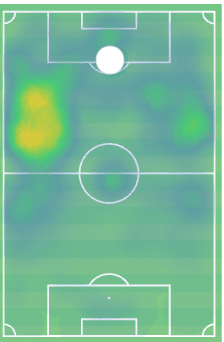
Firstly, figure 1 shows Ekitike’s heatmap for the 2021/22 season so far and it’s worth noting that while he’s primarily played as a centre-forward, he tends to drift around a lot, frequently occupying the left-wing position and often appearing on the right-wing too. Reims have used a large variety of different formations this term, including the 3-4-3, 4-1-4-1, and 4-2-3-1 on multiple occasions. However, they’ve primarily used something like a 3-5-2 and when this has been the case, Ekitike’s tended to occupy one of the two centre-forward positions, from where he typically enjoys a lot of freedom to roam about, which leads to the fairly well spread out heatmap seen above.
As this heatmap also suggests though, Ekitike’s preference is to come off of the left side and cut in onto his stronger right foot. We’ll look at his performances in wider areas in more detail later on in this tactical analysis piece but I think it’s worth noting his general positioning at the start of this piece to get an idea of where Ekitike will typically be found — he spends a lot of time on the wings but is really more of a centre-forward than a wide forward.
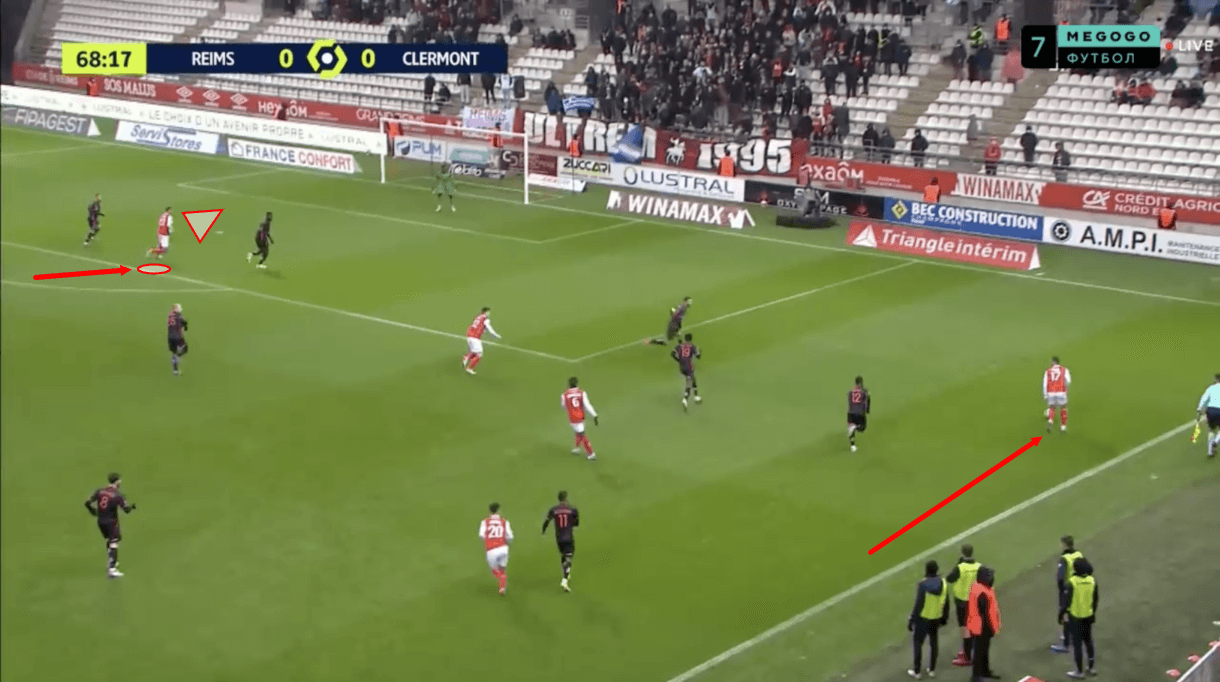
In terms of his attacking movement, I want to look at a couple of different in-game examples in this section. At 190cm, Ekitike provides a solid physical presence in the box but isn’t an incredible aerial threat — none of his goals this season have been headers. He is often targeted with crosses, though, and those crosses tend to be played along the ground. To successfully meet these crosses, Ekitike’s movement has to be on point and to convert them, his first-time finishing ability is often called into play. In figures 2-3, we’ll see an example of the type of solid off-the-ball movement that Ekitike regularly displays to meet low crosses in dangerous, high-value shooting positions.
Figure 2 shows Reims’ 19-year-old attacker in the box, positioned between two defenders while his teammate on the right-wing drives into space and progresses into a crossing position. From here, Ekitike could pull away towards the back post to give the crosser an option for a high ball but that’s not really what he tends to do most often. More frequently, we see the attacker act as he does in this example, where he targets the front post and aims to get onto the end of a low driven ball.
While that’s the attacker’s preference, the most impressive thing about Ekitike’s off-the-ball movement is his timing. He times his movements really well, generally trying to stay in space behind the defender, which we see here, waiting until the very last moment before his wide teammate crosses to burst in front. This blindside movement preceding the cross is intelligent as it simply makes it more difficult for the defender to mark him when he’s out of his line of sight and the defender is focused on the action in front of him. The subsequent burst in front of the defender to meet the cross then aims to catch the defender off-guard and make it difficult for them to prevent him from meeting the ball. This also requires a good level of understanding with his wide teammate, as both players need to understand the other’s preferences and intent to some level.
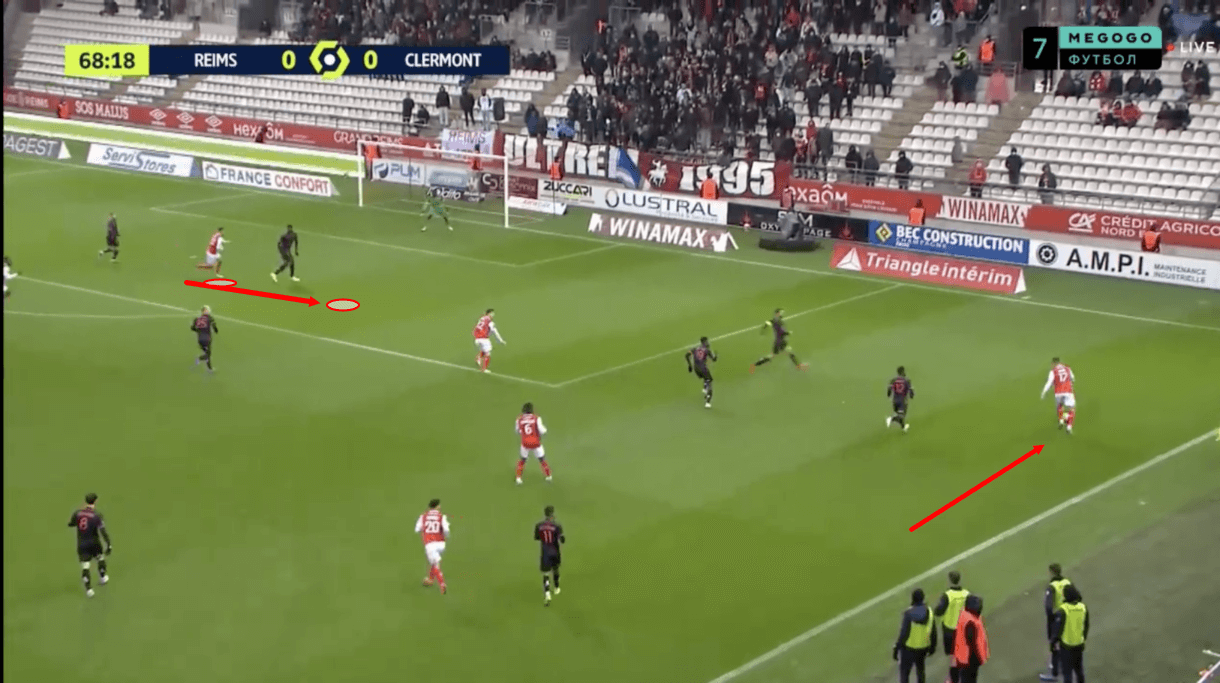
In this example, as play moves on into figure 3 a second later, we now see Ekitike looking to burst in front of the defender as the wide man in possession lifts his right foot to line up the cross. Note that as well as understanding with his teammate and knowledge of the defenders’ positioning, Ekitike needs to show good concentration and focus on the play developing to decide on the best moment to make his move. If he moves in front too early, this can give the defender time to react and if he moves too late, then the cross mightn’t make it to him at all. However, the 19-year-old consistently pulls off this movement effectively, demonstrating his high-level ability to time his runs.
In this particular example, the defender actually does a really good job by opening his body shape to see both the crosser and the man just as Ekitike makes his move in figure 3, which helps him to defend the attack successfully. However, more often than not, this movement results in a dangerous shot, as defenders don’t often position themselves as well as this, partially thanks to the quality of Ekitike’s movement.
In terms of his one-touch finishing ability, the majority of Ekitike’s goals this season have come in fast-paced situations when required to finish quickly with one touch. He’s excellent at firing rebounds into difficult-to-stop areas and redirecting low crosses like this towards the net with power and accuracy. With more time to think in front of goal, he’s not been as efficient. This isn’t necessarily a weakness at this point but he’s certainly specialised in quick, one-touch finishes this season.
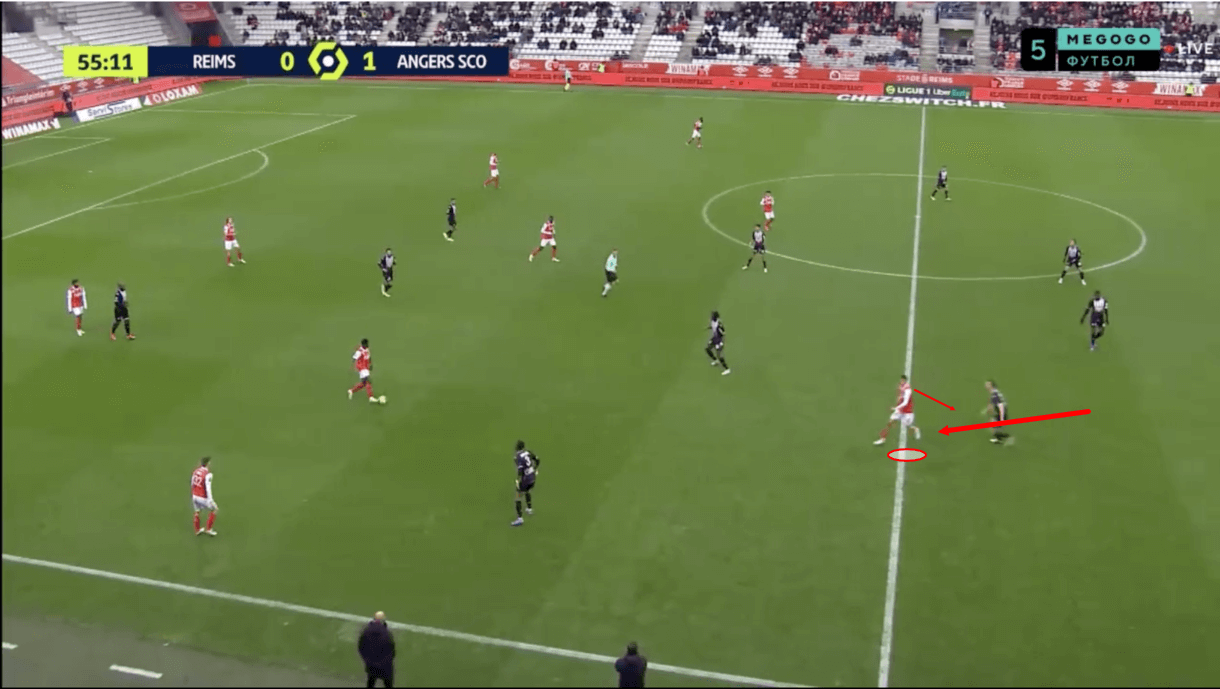
Ekitike’s not a one-dimensional forward; he plays a very open role within Reims’ strategy and tactics which requires him to use a large variety of skills. This has good and bad aspects but one of the better results of this is that Ekitike can be quite unpredictable and offer different options to his teammates, resulting in different problems for the opposition. The attacker has very long legs and runs with a long stride. He’s not extremely quick but can somewhat deceive with his pace at times and can provide an option in behind the opposition’s backline and drive into space when it’s there, as required. This is helped by his movement, as the passage of play in figures 4-5 shows.
Firstly, figure 4 shows Ekitike dropping off from the right centre-forward position into the right half-space, seemingly looking to exploit space behind the opposition’s midfield line and give a passing option to the midfielder sitting deep in this same vertical lane. This movement is intelligent because if he’s not followed by the defender, he can receive between the lines and either link up with a teammate from there or turn and drive at the backline but if he is followed by the defender, then he creates more space to attack in behind the opposition’s backline. Ekitike shares a quick look over his left shoulder while dropping deep, as seen in figure 4, to check what the defender is doing before deciding his next action and on seeing the defender follow him deep, the 19-year-old takes the opportunity to turn and drive into the space behind the opposition’s defence.
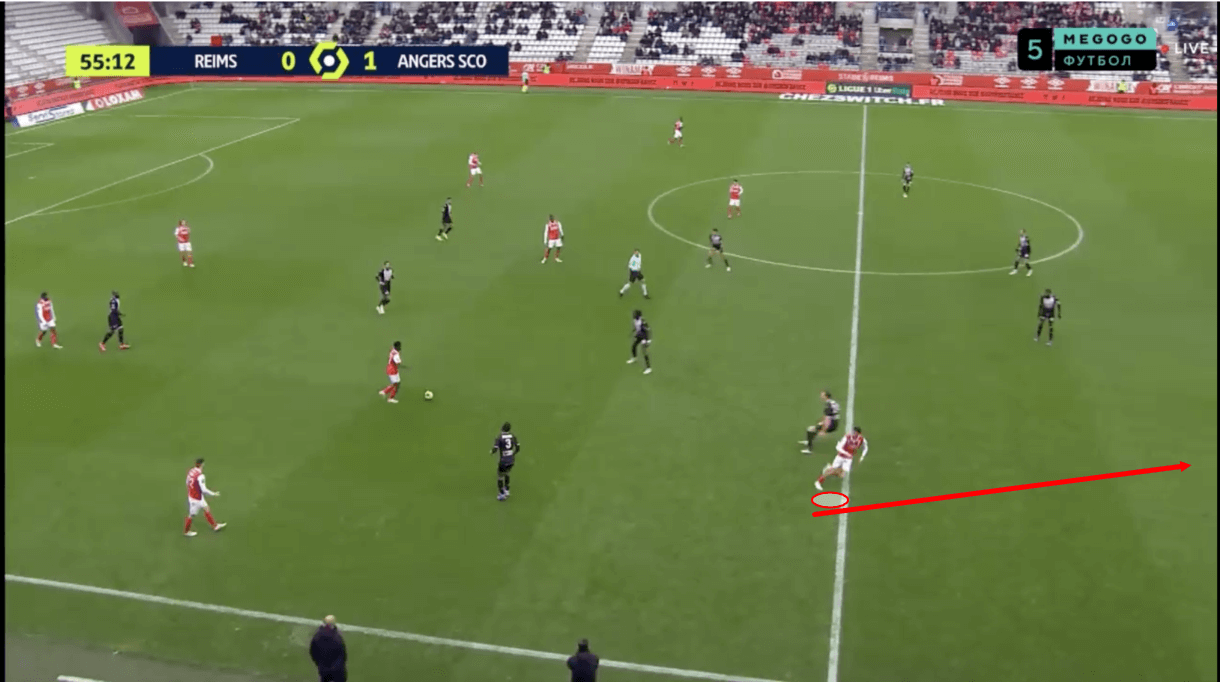
We see how effective this little bit of movement was in figure 5, as now Ekitike has a lot of space to target on the right-wing, with the opposition’s left centre-back taken out of the picture through the previous movement. As play moves on, the Reims passer sends a lofted through ball into Ekitike’s path and this move ultimately sets up a dangerous goalscoring opportunity for Les Rouges et Blancs.
This shows Ekitike’s solid spatial awareness, scanning diligence, and tactical understanding to successfully manipulate the opposition’s shape with very little movement. These are all very valuable qualities for a top-flight centre-forward and they highlight why and how Ekitike has adjusted to the level so well.
Work rate
Along with intelligent movement, tenacity, aggression and an impressive work rate are important qualities for Ekitike in the final third, as well as when defending in deeper areas. As mentioned in the previous section, Ekitike tends to finish off one touch quite a lot and his movement and anticipation help him to achieve this. However, his work rate and tenacity have also helped him to create some chances for himself, which have resulted in goals a couple of times, as this section of analysis will show.
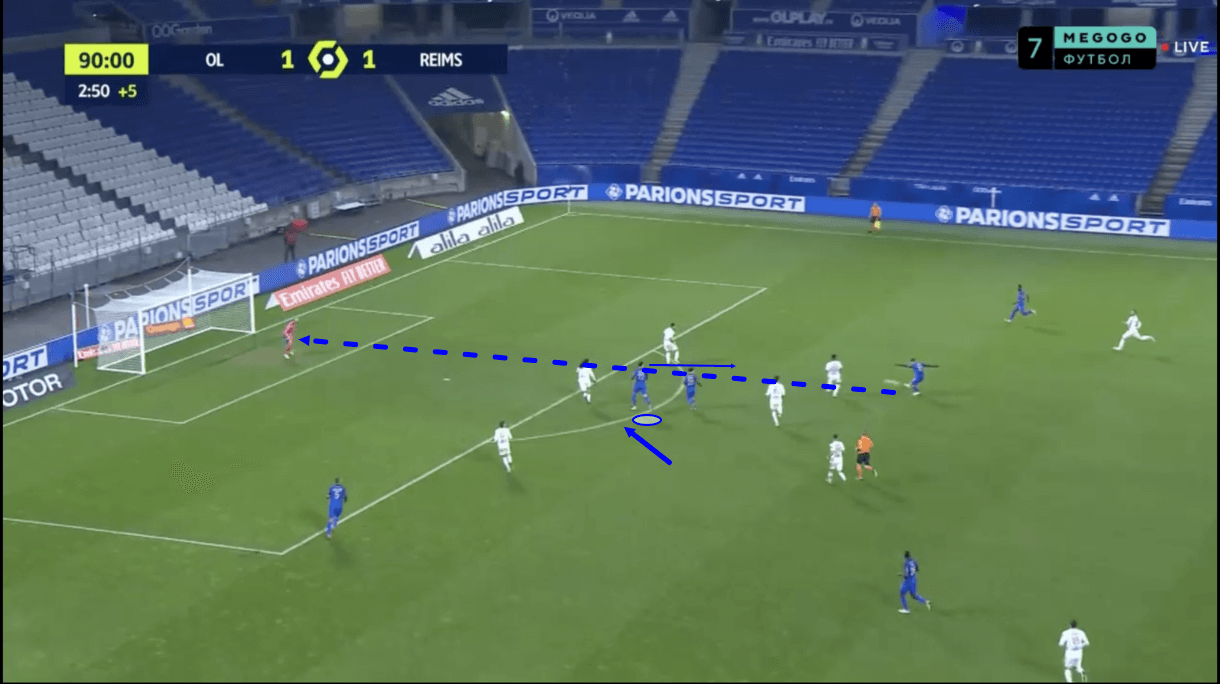
Firstly, work rate and tenacity help Ekitike to get onto the end of rebounds, which proved the difference between one point and three points in Les Rouges et Blancs Ligue 1 clash with Lyon at the beginning of this month. In figure 6, we see Ekitike on the edge of the box while his teammate, positioned maybe 10 yards deeper, lines up a long shot in the dying minutes of Reims’ visit to Groupama Stadium. At this point, Lyon centre-back Jason Denayer is a couple of yards closer to his goal than Ekitike is and has the advantage if the two need to compete to get onto the end of a rebound, should Lyon’s goalkeeper parry the long shot.
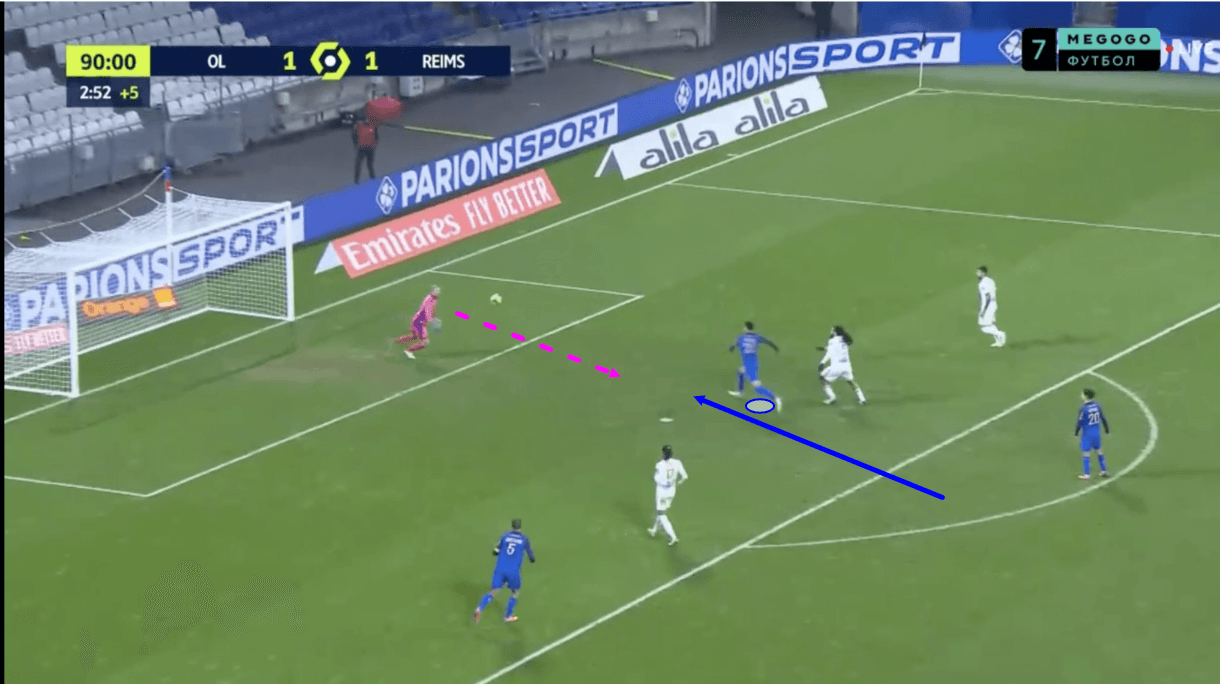
As play moves on into figure 7, we see that the ‘keeper did end up parrying the long shot and the ball didn’t get pushed wide or out of the box, but it ends up dropping right into the centre of the box — a very dangerous position. This wouldn’t have been a major problem had Denayer maintained his position in front of Ekitike by being alert and aware of his opponent’s positioning. However, as figure 7 shows, that’s not what transpired here. Instead, Ekitike demonstrated excellent awareness of his surroundings again by moving in as soon as this ball was struck by his teammate and getting himself in the perfect position to capitalise on the rebound, sending it into the net with one touch under pressure and scoring a crucial winner for his team.
His long strides helped him to gain an edge on Denayer here, but the key for Ekitike in getting onto the end of this rebound was his alertness and tenacity to ensure that if the ball were parried into the box, he’d be the one best-positioned to get onto the end of it.
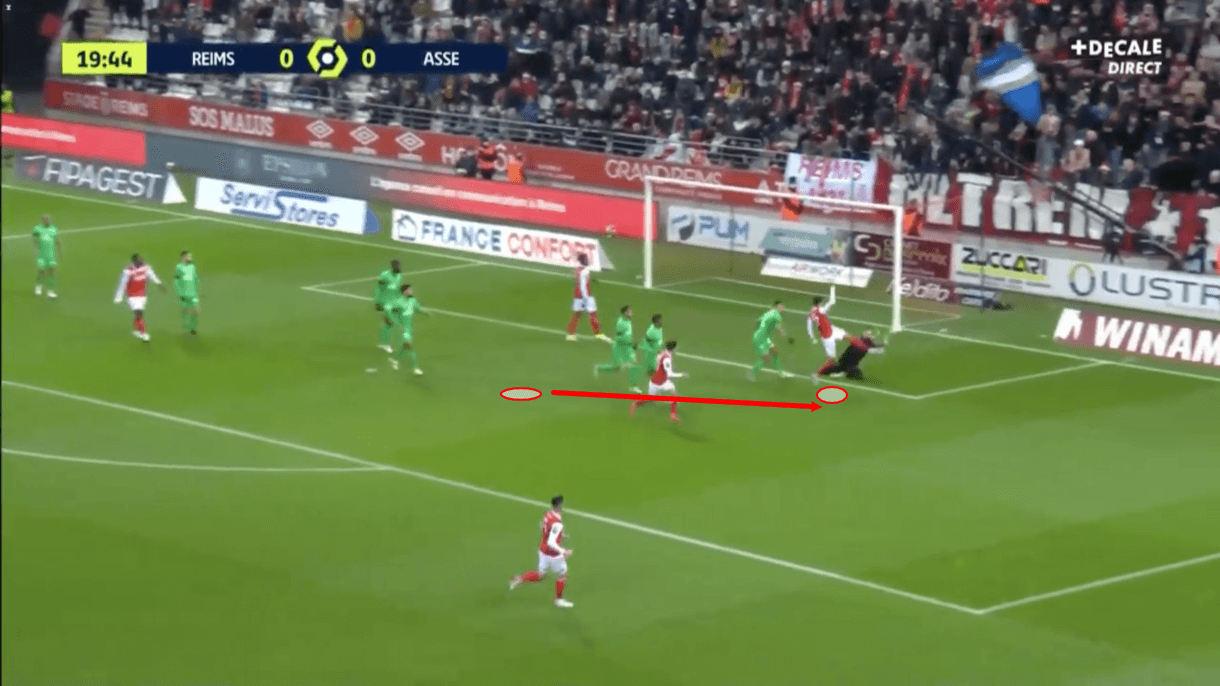
These mental traits paid off again in Reims’ most recent Ligue 1 game versus Saint-Étienne. Les Rouges et Blancs came away from this clash with a 2-0 victory and Ekitike played a significant role in his side’s opening goal, even though he didn’t score it himself. Just before figure 8, the ball was played to Ekitike in the box but his first touch let him down, taking the ball away from the centre of the box and away from his control.
This is actual not that uncommon for Ekitike; his first touch is promising and decent at times but can improve a lot. His first touch is inconsistent which leads to him taking control away from himself at times and ending up chasing the ball down to recover. This can occur in high-pressure situations but even when not under that much pressure too, so it’s definitely an area of improvement for the 19-year-old. At times, he shows great elegance on the ball but achieving that consistently will make him far more reliable.
The positive thing about the passage of play in figure 8, however, isn’t his poor first touch, but the tenacity he showed to chase the ball down, get in front of defenders and manage to get a foot to the ball before the opposition goalkeeper. The ‘keeper had already committed to diving for the ball at this point, evidently without expecting Ekitike to make it to the ball first. When the striker did, it caught the ‘keeper by surprise and punished him for committing to dive so early, as the attacker’s touch took the ball out of the ‘keeper’s path and led to Ekitike being fouled to win a clear as day penalty for his team. This spot-kick was subsequently converted by Ekitike’s teammate, El Bilal Touré, giving Reims a 1-0 lead in this one.
Again, this example shows how Ekitike’s tenacious mentality and work rate can combine to create chances out of nothing. While this attack could’ve been made easier by Ekitike not miscontrolling the ball initially, he made up for his error by working to put it right and did so excellently by bursting in front of the defenders, getting to the ball first and winning his side a penalty. This mentality is great to see in a teenaged striker and bodes well for the future, provided he maintains it.
Work rate and tenacity aren’t just useful traits for Ekitike in possession, but, of course, they’re also great traits for the forward to have out of possession. Ekitike is a great asset for his side without the ball, He’s required to do a lot of defensive work in his system and he does it diligently, to the best of his ability. Per Statsbomb via FBRef, this leads to Ekitike ranking in the 98th percentile (among other forwards from Europe’s top-five leagues over the past 365 days) in tackles and interceptions, the 92nd percentile for blocks, and the 83rd percentile for pressures (94th percentile for pressures in the defensive third, which says more about his team’s style than it does about his tendencies or preferences, but also says a lot about his willingness to do the defensive dirty work and get himself back defending in deeper areas).
Ekitike makes for a large presence on the pitch and isn’t afraid to throw his weight around in defensive phases. He’s very comfortable getting physical and shoulder barging in 50/50s. As you’d expect at just 19, he still has a lot of growing to do and can fill out his large frame much more, so I’d expect the physical part of his game to only improve in the future with increased training in this area. At present, he’s pretty good in this area but does leave plenty of room for improvement to become a proper physical presence on the pitch.
While Ekitike presses a lot, his pressure success isn’t amazing, which I’d attribute more to his awareness of passing lanes than his work rate. He can improve his pressing intelligence to not just work hard without the ball but also work smart, which is more important. However, it’s positive to see him have such a strong work rate and this makes me confident he’ll be willing to learn and improve his pressing intelligence, as both he and his team will benefit from this, in the long run, a lot more than if he just runs himself into the ground chasing opponents.
All in all, though, Ekitike has managed to make the ninth-most successful defensive actions (6.38 per 90) of any Ligue 1 attacker this term with more than 400 minutes played, which highlights that he is effective in defensive phases, largely thanks to his work rate and tenacity.
Furthermore, Ekitike displays excellent work rate and tenacity when engaging in aerial duels. Of course, his team often looks to him to compete in aerial duels as a result of his size and he gladly does so, with the forward having engaged in 5.13 aerial duels per 90 (high for a Ligue 1 attacker) this term. Ekitike is eager to get involved in aerial duels and get onto the end of long balls when required but he can work on the accuracy of his heading. Sometimes, he exerts all of his energy to make it to the drop zone ahead of the defender and then jumps but sends the ball straight into the path of a defender, which isn’t very productive. Additionally, Ekitike could work on knocking the ball down for teammates more, as opposed to knocking the ball straight up in the air for another 50/50. However, he’s physically decent in aerial duels and is somewhat reliable if needed to get onto the end of them, though his ability can improve along with his physicality.
Hold up play
Ekitike’s a forward who’s great in the box, as we saw earlier, and can provide an option when running in behind. However, he’s comfortable receiving the ball to feet and holding up the play as well and I could see him developing into more of a striker that typically stays centrally, occupying centre-backs and acting as a focal point for his team’s attack, which his ability to hold up the play will help him with enormously. However, there are some important areas of improvement for the attacker if he’s to successfully become this kind of player at the top level.
Ekitike frequently demonstrates lovely ball control when playing at a slower pace but when moving at a fast pace — and Ligue 1 is a fast-paced league of the highest quality — the ball can get a bit lost under his feet and in that situation, he’ll ultimately lose possession. Similarly, he’s agile enough to turn quickly and sharply, maybe to a surprising extent, even when under pressure while playing at a slower pace but, again, at the faster pace he’s often required to play as a centre-forward in Ligue 1, his ability to turn so quickly and sharply isn’t good enough and when he tries to do so, it typically results in a loss of possession.
Ekitike can indeed and should work on these areas but they aren’t unavoidable skills either and if he were to avoid trying to turn so quickly and sharply when playing at a faster pace and focus on doing what he’s better at, then that’s another effective solution. As mentioned earlier, Ekitike has a very free role at Reims right now but a more defined role, which he’ll likely move into in the future, will see him limit some aspects of his game and this is one that there’d be no harm in limiting in favour of a more controlled game. Given that he performs so well in terms of off-the-ball movement, perhaps the best solution is to allow Ekitike to do most of his movement in attack off the ball and make him less involved with the ball in chance creation. However, it’s also a skill that he can improve at, especially as he’s so new to the level, and it would be unfair to criticise his technical ability overall — as mentioned before, he’s good in this area at a slower pace, which is somewhat promising.
The Reims attacker is excellent from a standing position and can move the ball very quickly in such situations. He’s great at drawing defenders in from a standing position and moving the ball quickly to win fouls. As well as moving the ball, Ekitike’s good at moving his body around the ball quickly to draw a foul by forcing a defender to barge into his back. To achieve this kind of movement, we often see Ekitike perform standing stepovers fluidly and quickly.
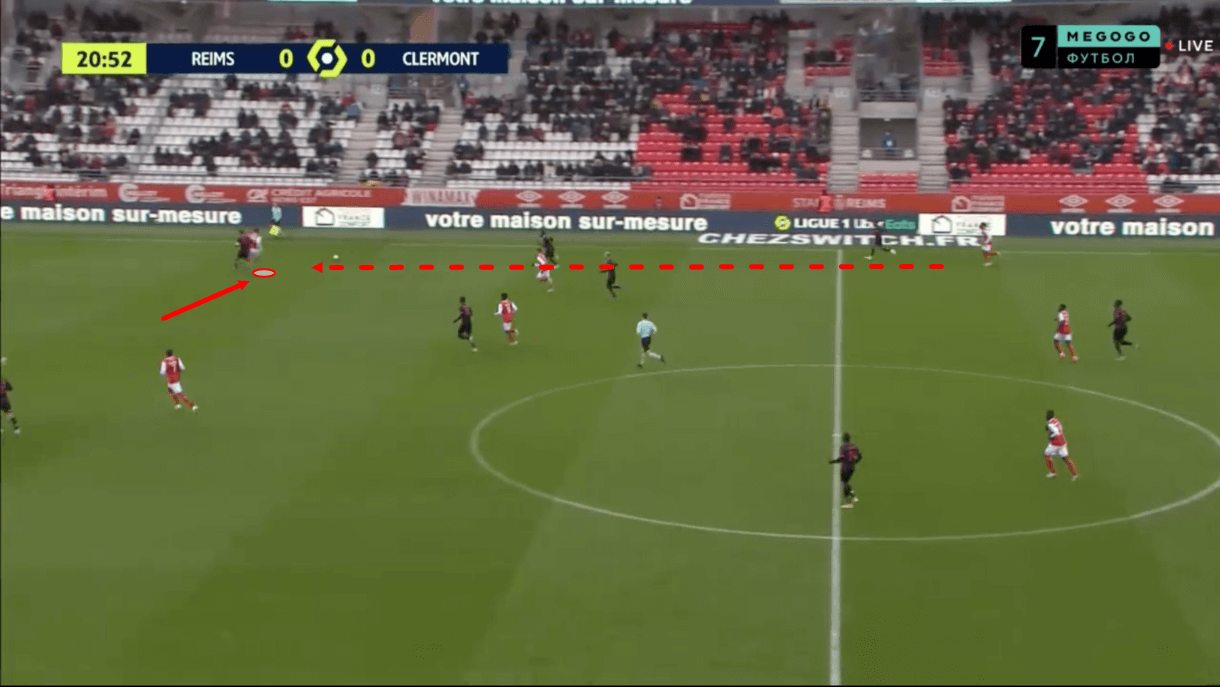
Figure 9 shows an example of Ekitike receiving a pass to feet with his back to goal, while moving from the centre of the pitch out to the right-wing. Before this image, the attacker was facing more towards the sideline with the possibility of turning to run at goal on receiving the pass still open. However, due to the defender’s presence behind him and Ekitike’s lack of total comfortability in offensive 1v1s, which we’ll discuss in greater detail later, he opted to turn his back to goal instead and back into the defender tracking him. In doing so, he decided to hold up the play and give his teammates time to get upfield in support.
Ekitike is comfortable with using his large frame to back into defenders and protect the ball in situations like this and generally does so to a decent level, though, again, he has plenty of room for improvement physically and this area of his game has the potential to improve exponentially in the future. His first touch should also improve to make Ekitike top-level in such situations. However, this example also shows another example of Ekitike’s intelligent movement. By moving out wide, he created a passing option for the full-back and also created space for his strike partner up front.
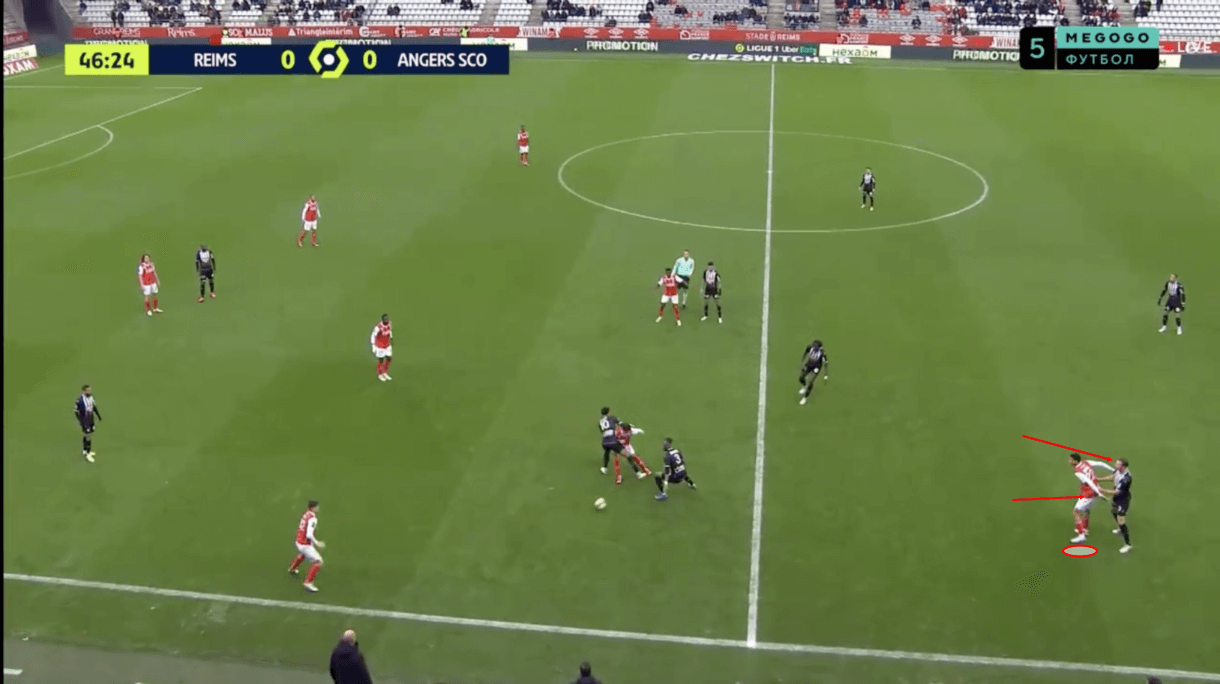
When backing into players from a standing position — preferable to what we saw in figure 9 where he backed into the player from a running angle — Ekitike tries to get his long, flexible arms back around the defender behind him. In doing so, he gives himself a sense of the defender’s movement and body positioning to an extent, helping him with his own decision-making before receiving the ball, while he can also control the defender’s movement to an extent and in this example of figure 10, keep him standing square, as opposed to side-on.
Ekitike can’t always do this; for example, in Reims’ recent Ligue 1 clash with Lyon, Denayer generally dealt with Ekitike’s physical presence really well and gave him very little throughout the game, for the most part, constantly forcing the engagement into preferable scenarios for him and ensuring he engaged with the attacker side-on. However, this is something small that can give Ekitike an edge in terms of spatial awareness, balance and shielding.
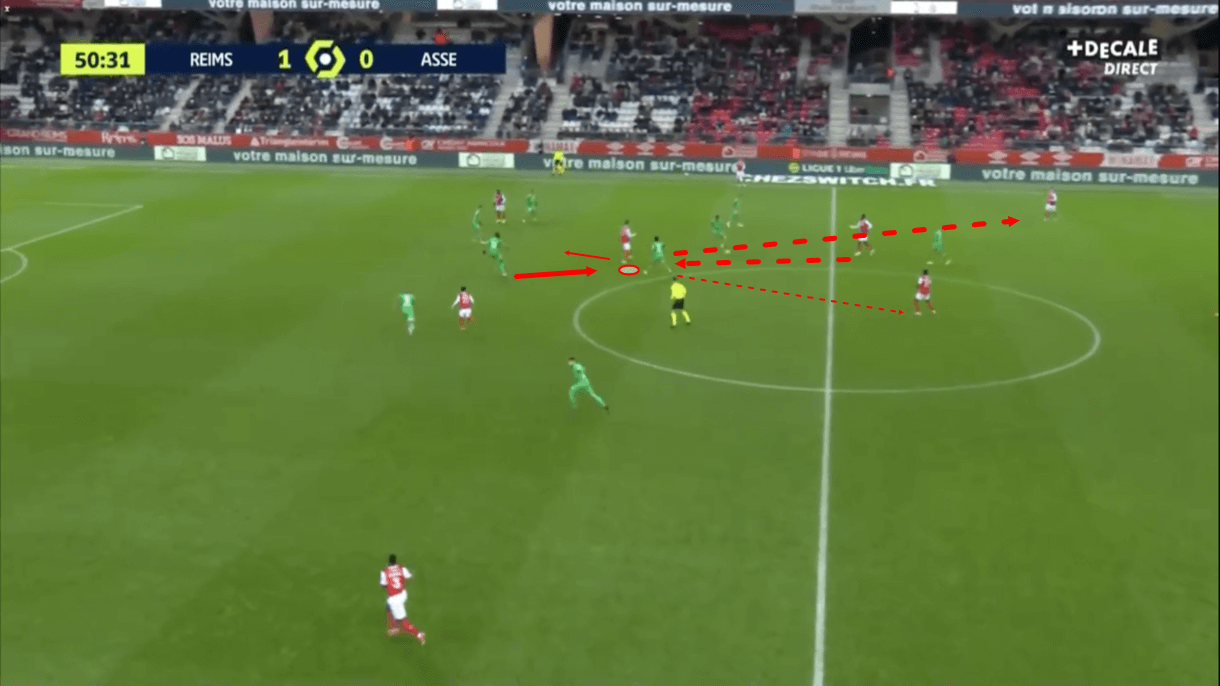
As far as link-up play, though, Ekitike leaves plenty of room for improvement. He plays a relatively low number of passes for a Ligue 1 attacker and could be better at showing for the ball, though isn’t terrible in this area — it’s mainly deciding on where to drop into and position himself that can improve to an extent. However, even with the passes Ekitike does play, he doesn’t have a great success rate, which doesn’t come as a major surprise.
As a centre-forward, many of his passes when dropping off to link up with teammates come while under pressure and as a result, the attacker is forced to play the pass with one touch. The issue with this is that Ekitike’s one-touch passing isn’t great and can improve in terms of technical quality. The execution isn’t consistent enough, similar to his first touch.
Also, Ekitike’s scanning, spatial awareness and body shape can improve when dropping off to receive and link up in deeper areas, with figure 11 providing an example of one such situation. Just before this image, the forward dropped away from the opposition centre-back, found some space between the lines and received this pass from the right central midfielder. However, even before receiving the ball, Ekitike came under pressure from the two opposition midfielders near him and he opted to immediately send the ball back, at pace, to his team’s right-back, putting them back behind the first line of pressure and into a poor position.
One of the other potential options here, had Ekitike scanned and/or been more spatially aware, was to receive and exit over his left shoulder to carry the ball forward himself, while a pass out to the right-winger was also a possibility, with that player then capable of carrying the ball forward. I think the best option here would’ve been for Ekitike to send the ball into the left central midfielder’s feet, as this was the most centrally positioned player on the pitch and he had lots of space to pick out a defence-splitting forward pass. However, Ekitike’s body shape was too closed to take this option, while he also didn’t scan quickly enough to see it. Instead, the ball was sent into arguably a worse position than it had been in before Ekitike got involved in the move, so this shows how, when linking up under pressure, the Reims starlet has plenty of room for improvement in terms of technical ability, scanning, spatial awareness and body shape.
Dribbling and passing
The teenager is a bit of a mixed bag as a dribbler. He’s not the most technically-proficient dribbler in the world and won’t go on mazy runs carrying the ball through the opposition’s defence, nor will he really even enter into many 1v1s and come out on top. His fairly average 45.45% dribble success rate for the 2021/22 campaign highlights that he’s not operating as an outstanding dribbler at present. He’s not poor on the ball or poor technically at all, he’s just not a very tricky dribbler. He does take on plenty of dribbles, though (5.01 per 90), and performs very well in specific situations.
While Ekitke isn’t great in 1v1s, he’s very good at driving into space with the ball. While dribbling, it’s common to see him scanning very intelligently in between touches to retain an accurate, up-to-date picture of the lay of the land surrounding him to help with his decision-making ahead of his next move — usually a pass, as he won’t look to take players on 1v1 a lot.
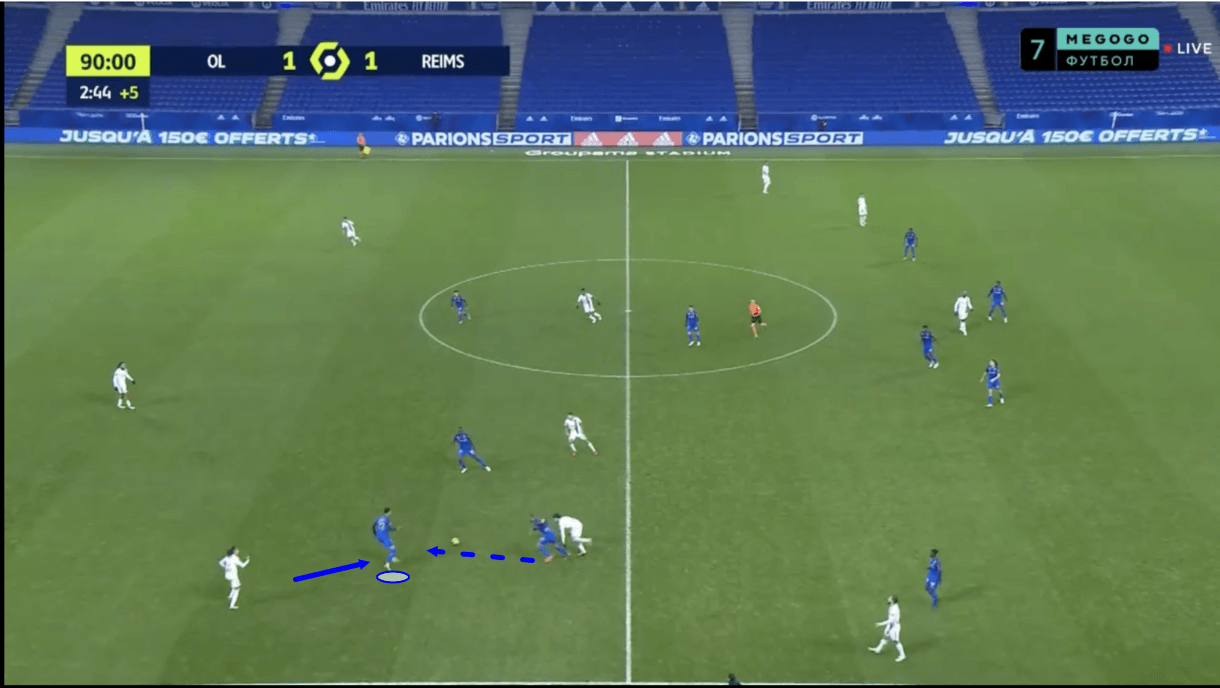
As mentioned at the beginning of this scout report, Ekitike spends a lot of time out in the wide areas, especially the left-wing, such as where we see him in figure 12. From here, though we do see him picking the ball up closer to the box at times and trying to take on the opposition full-back 1v1, I think he’s better when driving into space, especially in transition (again, as is the case here), from deep. This may be the case because Ekitike is quite heavily right-footed and can be predictable as a dribble. He likes to keep the ball on his right foot, which can telegraph his intent to either cut in or go outside (depending on what wing he’s occupying) to the defender.
Coming from deep, with more space to run into, however, Ekitike has proven to be a danger. In these situations, he can use his long strides to make up ground quickly while moving into a threatening area, attract defenders towards him and scan in between touches to remain aware of his surroundings.
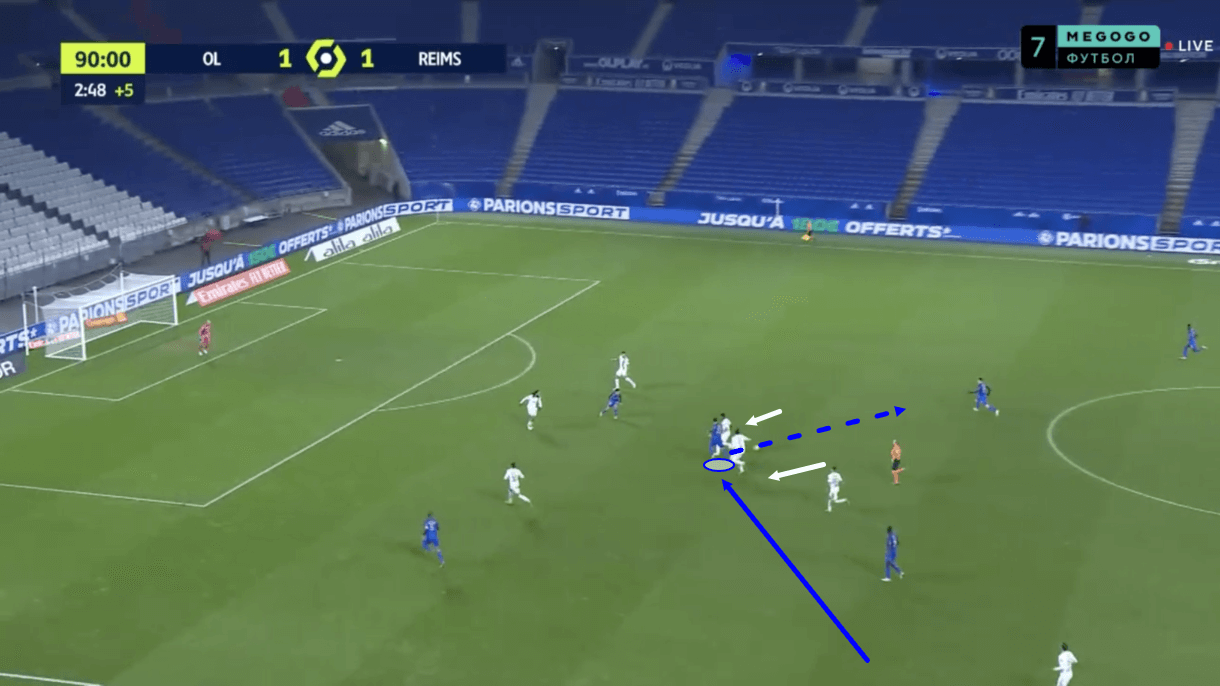
This is exactly what happened on this occasion. After driving inside from the left-wing, figure 13 shows how Ekitike attracted two defenders towards him on the right before pulling off a creative, subtle pass to a teammate in space with the outside of his right boot. Ekitike’s technical ability is much more impressive in situations like this where he’s got more time and space to think, so his team needs to put him in these situations as frequently as possible to get the best out of him, which they’ve made a good job of this term. He’s great at playing clever, subtle passes with the outside of his boot like we see here or with a backheel, etc. Additionally, thanks to his diligent and intelligent scanning, he remains aware of the free men and movement around him.
In this particular example, Ekitike’s drive infield and clever, subtle pass to a teammate in space led to the long shot that led to Ekitike’s rebound winner versus Lyon, so we can see how this ability of his proved vital for his side in this instance.
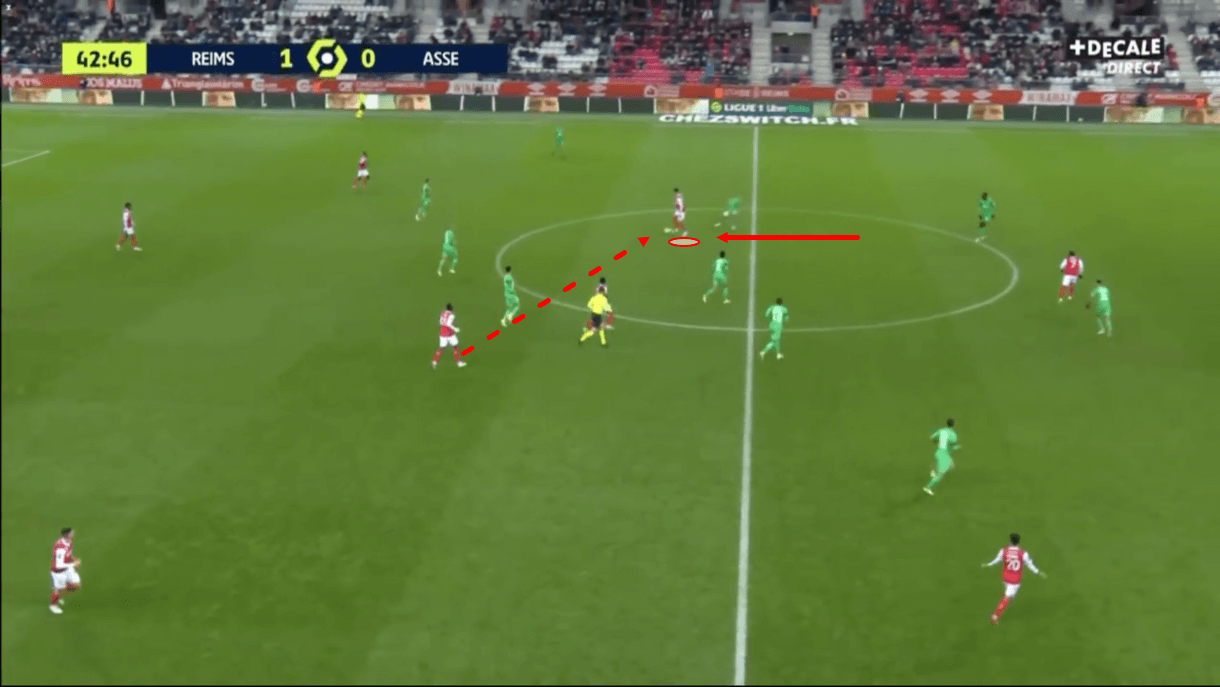
As mentioned earlier, Ekitike is good at turning quickly and sharply from a standing position. He struggles to do so more at fast pace but from a standing position, he’s very good at readjusting and bursting away. Figures 14-15 show an example of one movement, in particular, that Ekitike often makes from a standing position to successfully dupe defenders. Firstly, in figure 14, Ekitike has just dropped deep, dragging a defender with him, and received a pass on his far foot. After scanning to make himself aware of the defender’s movement, he started to turn out over his right shoulder, in the direction of the ball.
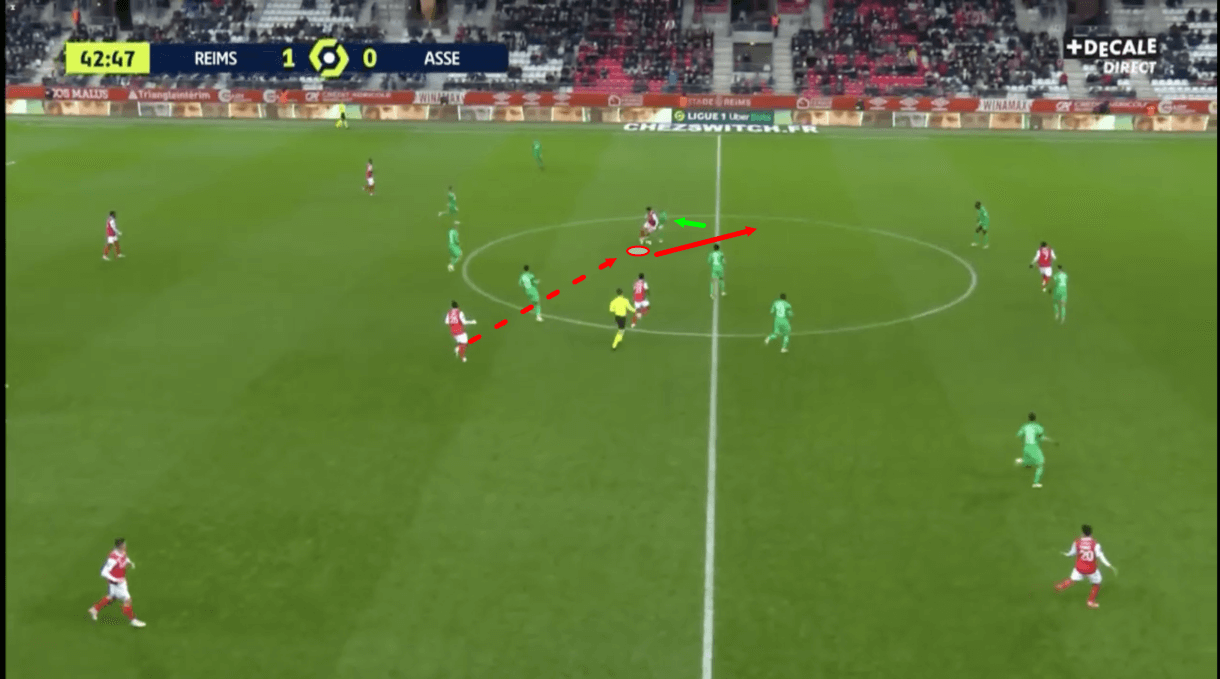
However, he did this with the intent of influencing the defender to commit to engaging and protecting that side and as soon as the defender made his move in figure 15, Ekitike displayed the somewhat unexpected high-level agility required to turn out in the opposite direction, taking the ball out of the defender’s path, before exiting over his left shoulder to beat this defender 1v1 and progress his team upfield.
This highlights Ekitike’s technical proficiency in slower-paced moments and dribbling quality from a standing position. We know he’s not great while taking defenders on 1v1 and dribbling at pace but he has excellent ball control from a standing position and this, combined with his impressive agility in such situations, can leave defenders for dust after attracting them in initially. He’s great at pulling off effective dribbles like this after drawing the defender in.
Conclusion
To conclude this tactical analysis and scout report, Ekitike is a promising forward who’s proficient in off-the-ball movement, one-touch finishing, tenacity, work rate, driving into space and protecting the ball in a standing position. Meanwhile, his one-touch passing, physicality, heading accuracy and 1v1 dribbling are all key areas of improvement for Ekitike to reach the next level of his development.
As mentioned earlier, Ekitike enjoys a lot of freedom in his role right now and a lot of potential avenues are open for him to fit into in the future. I think he’s got the qualities to play in either a two-man strike partnership or as a lone-striker. Right now, I think his future lies at centre-forward, in a more stationary role where his work in chance creation is primarily done off the ball. He must improve his hold-up play, particularly his one-touch passing, his strength and aerial ability to perform this role at the top level, however.





Comments